Questions to Ask About Your Prescription Label at the Pharmacy
Every year, over 4.9 billion prescriptions are filled in the U.S. That’s more than 15 million per day. Most of them go home with clear labels-but not everyone understands what they say. And that’s where things get dangerous. A simple mistake-like taking the wrong dose, mixing meds with food, or storing pills in the wrong place-can lead to serious harm. The FDA says 1.3 million medication errors happen annually in the U.S., and over 20% of them come from misreading the prescription label. You don’t need to be a doctor to catch these mistakes. You just need to ask the right questions.
What’s the exact name of this medicine?
Brand name? Generic? Both? Your label might say "Lipitor," but the generic is "atorvastatin." Some pharmacies list both, others only one. If you’ve taken this drug before and it looks different-smaller, different color, odd shape-don’t assume it’s the same. Ask: "Is this the same medicine I got last time?" A 2023 study found that 18% of patients didn’t realize their new prescription was a generic version, leading to confusion about side effects or effectiveness. Always confirm the name matches what your doctor told you.Why am I taking this?
The label doesn’t always explain why. It just says "take one tablet daily." But knowing the reason helps you spot problems. If you were prescribed a blood thinner but your doctor only mentioned high cholesterol, something’s off. Ask: "What condition is this for?" If you’re taking multiple medications, ask how this one fits into your overall plan. A pharmacist at a Kroger in Austin once helped a 72-year-old woman realize she was getting two different drugs for the same blood pressure issue-doubling her risk of dizziness and falls. She asked the question. She avoided a hospital trip.How and when should I take it?
Look at the directions. Do they say "take with food"? "Take on an empty stomach"? "Take at bedtime"? These aren’t suggestions-they’re science. Some meds need food to be absorbed. Others get ruined by it. Antibiotics like tetracycline lose effectiveness if taken with dairy. Blood pressure pills like lisinopril work better if taken in the morning. Ask: "Should I take this with meals? At night? With water or juice?" And if the label says "as directed," ask for specifics. Don’t guess. 67% of medication errors happen at the point of administration, according to Pfizer’s safety data. That’s when you’re holding the pill.What if I miss a dose?
This is one of the most common questions people forget to ask. If you skip a dose of your antidepressant, you might feel off. Skip a dose of your insulin? That’s dangerous. The label won’t tell you what to do. Ask: "If I forget, should I take it as soon as I remember, or wait until tomorrow?" Some meds require you to skip it entirely. Others need a double dose. Getting this wrong can undo weeks of treatment-or trigger a crisis. A 2022 survey showed 41% of older adults didn’t know what to do when they missed a dose. That’s not ignorance-it’s a system failure.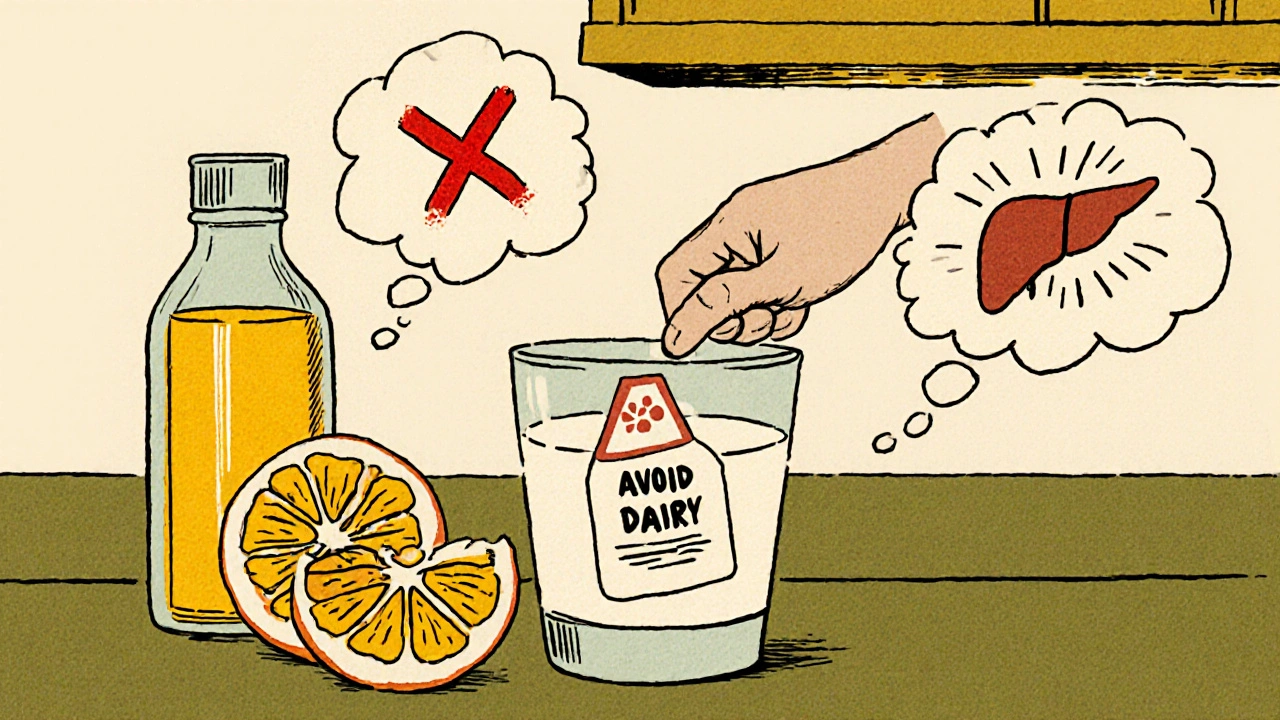
What foods, drinks, or other meds should I avoid?
Grapefruit juice can make some cholesterol drugs toxic. Alcohol can turn painkillers into liver bombs. Even over-the-counter stuff like ibuprofen can clash with blood thinners. Your label might mention one or two, but not all. Ask: "What should I not eat, drink, or take with this?" Include supplements. People think herbal stuff is safe. It’s not. St. John’s Wort can interfere with antidepressants, birth control, and heart meds. A 2023 report from the American Pharmacists Association found that 54% of patients didn’t tell their pharmacist about their supplements. That’s a hidden risk.How should I store this?
Most people keep meds in the bathroom cabinet. Bad idea. Heat and moisture ruin pills. Some drugs need refrigeration-like insulin, certain antibiotics, and eye drops. Others need to stay dry and cool. The label might say "store at room temperature," but what’s room temperature? It’s 68-77°F. That’s not your hot garage or sunlit windowsill. Ask: "Does this need to be kept cold?" One woman in Texas kept her blood pressure med at room temperature for two weeks because the tiny print on the back said "refrigerate." She didn’t see it. Her doctor found out when her numbers spiked. 15% of all prescriptions need refrigeration. Don’t assume.What are the side effects I should watch for?
The label lists side effects in tiny print. Most people skip it. But you don’t need to read every one. Ask: "What are the top three side effects I should call you about?" For example, if you’re on an opioid, you need to know if breathing becomes shallow. If you’re on a statin, muscle pain could mean a dangerous condition called rhabdomyolysis. The FDA requires Medication Guides for 107 high-risk drugs-opioids, blood thinners, diabetes meds. But even if you don’t get one, ask. A 2023 study showed patients who asked about side effects were 47% less likely to have a bad reaction. That’s not luck. That’s awareness.How many refills do I have left?
This seems obvious, but people run out. And then they skip doses or try to stretch pills. Ask: "How many refills are left? When will I need to call for a new prescription?" Some states require pharmacies to print refill info clearly. Others don’t. Your label might say "Refills: 3," but if your insurance changed or your doctor limited it, that number might be wrong. A 2022 Medicare report found that 28% of seniors ran out of meds because they didn’t know their refill count had changed. Don’t wait until you’re out. Ask now.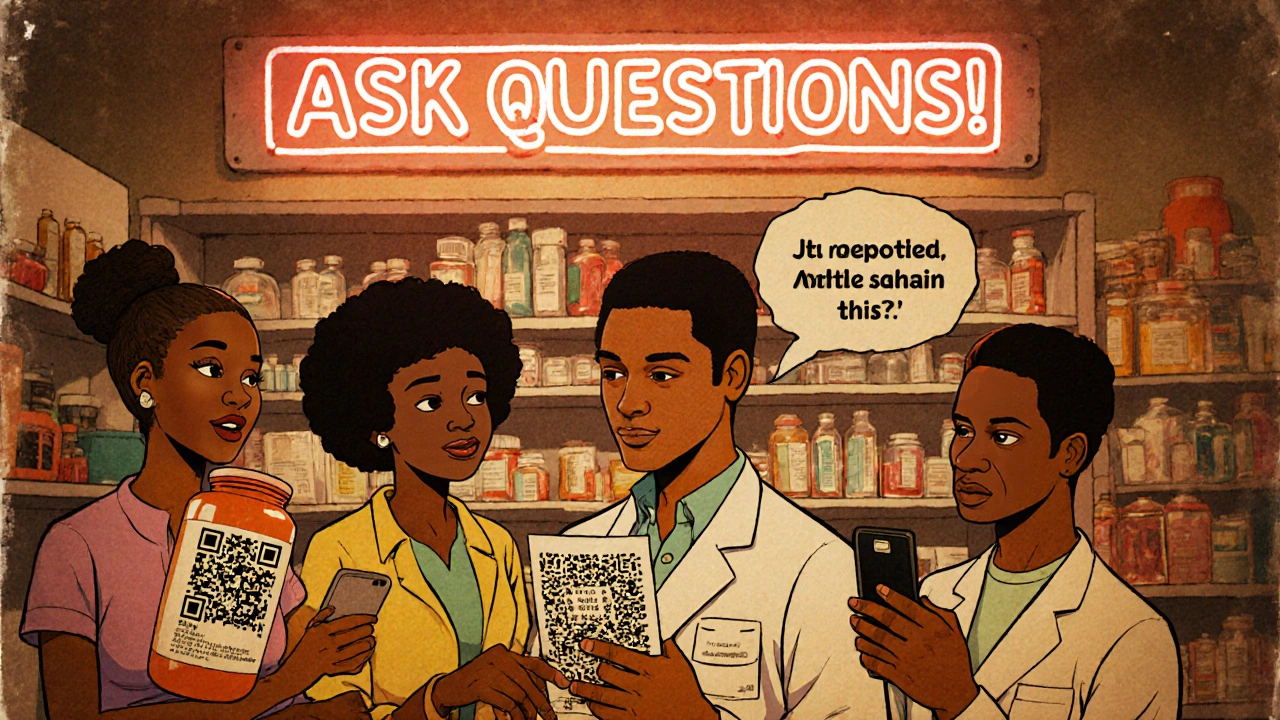
Can you explain this label to me out loud?
Don’t just take the label and walk out. Ask the pharmacist: "Can you walk me through this?" Say it back to them. "So, I take one blue pill every morning with breakfast, not with grapefruit juice, and I store it in the fridge?" This isn’t awkward-it’s smart. The Institute for Safe Medication Practices calls this the "5 Rights" check: Right Patient, Right Medicine, Right Dose, Right Route, Right Time. If you can say all five out loud, you’re covered. Independent pharmacies do this naturally. Chain pharmacies? Sometimes they’re rushed. But you have the right to ask. And if they hesitate? That’s a red flag.Is there a bigger print version? Or a digital version?
If the print is too small, ask for large-print labels. 92% of U.S. pharmacies offer this for free. You can also ask for a QR code. Many pharmacies now link to short video instructions. Scan it with your phone. You’ll see someone demonstrating how to take the pill, what to avoid, and how to store it. In pilot programs, this cut errors by 31%. If your pharmacy doesn’t have it yet, ask them to start. The FDA’s 2023 Draft Guidance encourages exactly this. You’re not being difficult. You’re protecting your health.What if I still don’t understand?
You’re not alone. 80 million American adults struggle to understand basic medical instructions. That’s not your fault. Ask for a translator. If you speak Spanish, Mandarin, or any of the 350 languages spoken in U.S. homes, federal law requires pharmacies to provide free interpretation services. Ask for a language line. If you’re visually impaired, ask for an audio label or braille version. Some pharmacies now offer voice-recorded instructions. If you’re still unsure, call your doctor’s office. They can clarify. Or visit a participating pharmacy in the FDA’s free "Medication Check-Up" program. It’s available at over 8,400 locations nationwide.What’s changing soon?
By 2026, all high-risk prescriptions in the U.S. will need scannable QR codes that link to up-to-date safety info. The FDA is also pushing for standardized warning labels for drugs like opioids and blood thinners. Some states are already testing AI-powered labels that adjust text size and language based on your health literacy. This isn’t science fiction-it’s coming fast. The sooner you learn to read and question your current label, the better prepared you’ll be.What should I do if the prescription label looks wrong?
If the name, dose, or instructions don’t match what your doctor told you, don’t take it. Call the pharmacy immediately. If they say it’s correct, call your doctor’s office to verify. Keep the bottle and label-you may need to show it. Mistakes happen, but they’re fixable if caught early. Never guess.
Can I get a printed copy of the full drug information?
Yes. Ask for the Medication Guide if it’s a high-risk drug. Even if you don’t get one, ask for the FDA-approved prescribing information. Most pharmacies can print it or email it. It’s longer, but it explains side effects, interactions, and warnings in detail. Keep it with your other medical records.
Why do different pharmacies label the same drug differently?
Because each state has its own rules. Some require generic names. Others require extra warnings. Some mandate large print. The federal rules are the floor, not the ceiling. A label from CVS in Texas might look different than one from a pharmacy in California. That’s why asking questions is more important than ever-don’t assume consistency.
How do I know if my medicine has expired?
Look for the expiration date printed on the bottle or box. It’s usually in MM/YY or MM/YYYY format. If it’s expired, don’t take it-even if it looks fine. Pills lose potency. Liquid meds can grow bacteria. The FDA says expired meds aren’t necessarily dangerous, but they won’t work as intended. Always check before you take a pill.
Should I keep all my prescriptions in one place?
Yes. Use a pill organizer or a labeled box. Keep them in a cool, dry place away from kids and pets. Never mix pills from different prescriptions in one container-it’s a recipe for confusion. If you take eight meds a day, write down the schedule. Bring it to every doctor visit. It helps prevent dangerous overlaps.
Taking control of your prescription label isn’t about being difficult. It’s about being safe. You’re not just a patient-you’re the last line of defense. Ask the questions. Double-check the details. Speak up. Your health depends on it.


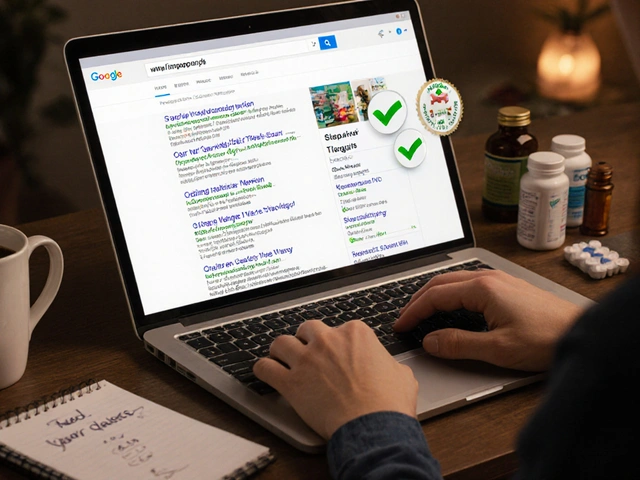
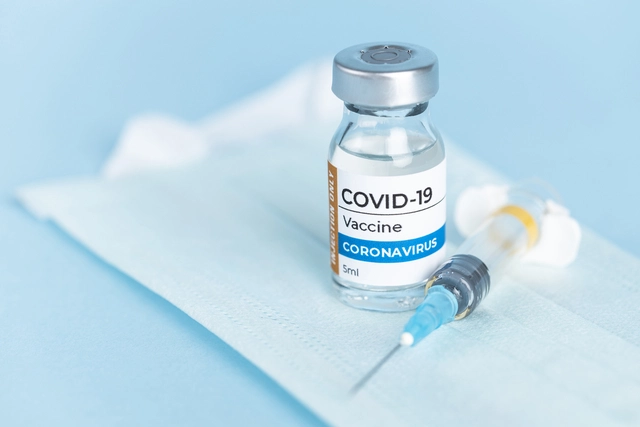
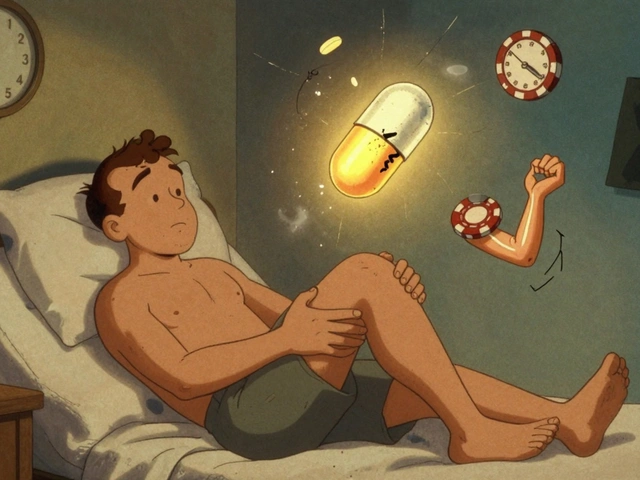


16 Comments
Jenny Lee
November 18, 2025 at 04:09
Just asked my pharmacist to walk me through my new script last week. She laughed and said, "Finally, someone who actually reads the damn label." Best 3 minutes of my life.
Evan Brady
November 19, 2025 at 00:37
My grandma used to keep all her meds in a Tupperware container labeled "Misc Pills." One day she took my dad’s blood thinner thinking it was "the heart one." She ended up in the ER. Don’t be her. Ask the questions. Write it down. Use a pillbox. Your future self will thank you.
Alex Boozan
November 20, 2025 at 22:52
The FDA’s 1.3 million medication error statistic? That’s just the tip of the iceberg. The real number is masked by corporate liability shields and pharmacy chain SOPs that prioritize throughput over patient safety. They don’t want you asking questions-they want you to swallow the pill and walk out. That’s not healthcare. That’s pharmaceutical logistics with a white coat.
Brandon Lowi
November 22, 2025 at 14:13
Why do they even print labels in 5-point font? It’s not a puzzle. It’s a medical directive. And yet, they treat patients like they’re supposed to squint through a microscope to read if they’re supposed to live or die. This isn’t negligence-it’s systemic dehumanization disguised as efficiency. And don’t get me started on the QR codes. They’re just another way to push you toward the app economy while they profit off your vulnerability.
Premanka Goswami
November 24, 2025 at 13:25
Let’s be real-the whole system is rigged. The pills? Made overseas under lax regulations. The labels? Designed by lawyers who want to cover their asses, not help you. And the pharmacists? Paid by the volume, not the care. They’ve got 90 seconds to process your script. You think they care if you know what "atorvastatin" is? Nah. They just want you gone so they can move on to the next person. The only person who’s gonna save you… is you. And even then, you’re fighting a machine that wants you docile.
Shravan Jain
November 25, 2025 at 14:59
Let me just say-this entire post is a performative compliance fantasy. You think asking "why am I taking this?" changes anything? The doctor wrote the script. The pharmacy filled it. The insurance approved it. You’re not a patient. You’re a data point in a profit algorithm. The label is a legal shield, not a guide. Asking questions won’t fix the system-it’ll just make you look like a nuisance. And in the eyes of Big Pharma? Nuisances get deprioritized.
Joshua Casella
November 26, 2025 at 18:42
I’ve been a pharmacy tech for 12 years. I’ve seen people cry because they couldn’t read the label. I’ve seen grandparents take the wrong pill because the font was too small. I’ve seen kids take their mom’s blood pressure med thinking it was candy. This isn’t just about asking questions-it’s about design. We need bigger fonts. We need audio labels. We need plain language. And we need to stop treating patients like they’re supposed to be medical experts just to survive.
Richard Couron
November 27, 2025 at 16:36
They’re lying to you. Every damn one of them. The label says "take with food"? Yeah, right. That’s just so they can claim you didn’t follow instructions when you get sick. The real reason? The drug company doesn’t want you taking it on an empty stomach because it makes you vomit and they get sued. The government lets them do it because they’re too busy kissing pharma’s ass to protect you. Don’t trust the label. Don’t trust the pharmacist. Trust your gut-and record every conversation. You never know when you’ll need it.
Saket Sharma
November 27, 2025 at 20:47
Let me break this down for the uneducated: If you don’t know the difference between generic and brand, you’re already dead weight in the healthcare system. You think your insurance cares? No. You think your doctor cares? No. They write the script. The pharmacy fills it. You? You’re just the meat sack that’s supposed to figure it out. And if you die? Well, there’s another one waiting in line. Ask questions? Please. That’s not empowerment-that’s a waste of time. The system is designed to fail you. Accept it.
Erica Lundy
November 29, 2025 at 02:11
There is a profound epistemological rupture in the patient-provider relationship when the burden of medical literacy is shifted entirely onto the individual. The prescription label, as a textual artifact, functions not as an instrument of care, but as a bureaucratic token-a performative act of liability mitigation. The individual, stripped of contextual knowledge, is expected to interpret a semiotic system they did not construct, under conditions of cognitive overload, emotional distress, and systemic disempowerment. To ask questions is not merely prudent-it is an act of ontological reclamation.
mithun mohanta
November 29, 2025 at 10:44
OMG. I just realized I’ve been storing my insulin in the bathroom for 3 years. 😱 I thought "room temperature" meant "wherever I keep my toothpaste." Now I’m panicking. Is my pancreas dead? Is this why I’ve been so tired? I need to call my doctor. But also-why does the label say "refrigerate" in 2-point font? Is this a joke? Who designed this? Did they even take medicine before? I’m not mad-I’m just… devastated. This system is broken. And I’m just a human trying to survive.
Kevin Jones
November 30, 2025 at 03:53
They don’t want you to know what’s in your pills. They want you docile. Quiet. Accepting. The label isn’t there to inform you-it’s there to absolve them. If you get hurt? You didn’t follow instructions. Not their fault. That’s the game. And if you ask too many questions? You’re labeled "difficult." And guess what? Difficult patients get ignored. Put on hold. Denied refills. You think this is about safety? No. It’s about control. And you’re the one being controlled.
Denny Sucipto
December 1, 2025 at 08:25
I used to be scared to ask questions at the pharmacy. Thought I’d look dumb. Then my mom had a bad reaction to a new med. Turned out the label said "take with food" but the pharmacist didn’t say a word. I started asking everything since. Now I say it back to them: "So, one blue pill every morning with breakfast, no grapefruit, fridge only?" They start smiling. They feel seen. And honestly? So do I. You’re not being annoying. You’re being brave.
Christine Eslinger
December 1, 2025 at 12:00
My cousin in rural Alabama didn’t know what "generic" meant. She thought her new pill was a different drug because it was white instead of blue. She stopped taking it. Her diabetes spiraled. She ended up in the hospital. All because no one took 30 seconds to explain it. This isn’t about being smart. It’s about being kind. If you’re reading this-you’re already ahead. Pass this on. Tell someone. Don’t let silence kill.
Alexis Paredes Gallego
December 3, 2025 at 02:08
QR codes? AI labels? Standardized warnings? Please. This is all just distraction theater. The real issue? The government sold out to Big Pharma decades ago. The labels won’t save you. The system won’t change. They’re just polishing the coffin so you think it’s a luxury car. You think asking questions will fix it? Nah. You think the pharmacist cares? Nah. You think your doctor remembers your name? Probably not. The only thing that matters now? Get your meds. Stay alive. And pray they don’t make a mistake… because if they do? You’re on your own.
Ram tech
December 4, 2025 at 03:57
why even bother reading the label? its all the same shit anyway. i just take what they give me. if i die, i die. if i live, i live. no point stressing. also the print is tiny. my eyes hurt.